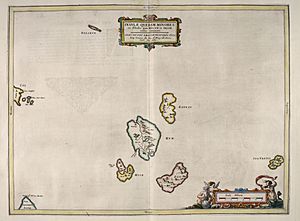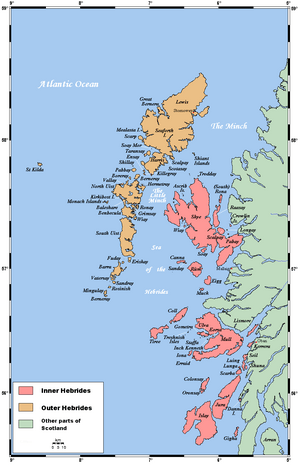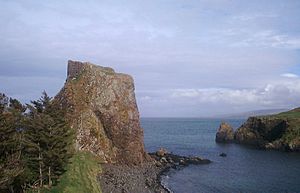Small Isles facts for kids
The Small Isles are a group of four main islands: Muck, Rùm, Eigg, and Canna. There are also a few smaller islands nearby. These islands form a small archipelago (a group of islands) in the Inner Hebrides, which is off the west coast of Scotland.
The Small Isles are located south of the Isle of Skye and north of Mull and Ardnamurchan. This area is so beautiful that it is one of 40 National Scenic Areas in Scotland. You can visit these islands by taking a ferry from either Arisaig or Mallaig on the Scottish mainland.

Contents
What Are the Small Isles?
The Small Isles are a special part of Scotland. They are known for their amazing nature and history. Each of the four main islands has its own unique features and stories.
Rùm: The Largest Island
Rùm is the biggest of the Small Isles. It is famous for its wild landscapes and mountains. Rùm is a great place for wildlife, especially for red deer. It is also home to the fancy Kinloch Castle. This castle was built a long time ago by a rich family.
Eigg: A Community Island
Eigg is known for its strong community spirit. The people who live on Eigg own the island together. This happened in 1997, which was a big moment for them. Eigg has a unique hill called An Sgùrr, which is a large, steep rock. The island also uses its own green energy, like wind and water power.
Canna: The Garden Island
Canna is often called the "Garden Island" because it has many beautiful plants. It is connected to a smaller island called Sanday by a bridge. Canna is also known for its puffins and other seabirds. There are old ruins on Canna, like Coroghon Castle, which tell stories of its past.
Muck: The Low-Lying Island
Muck is the smallest and lowest of the main Small Isles. It is a peaceful island, mostly used for farming. Muck is a good place to see seals and porpoises in the waters around it. It has a small pier where the ferry arrives.
How Were the Islands Formed?
The Small Isles were formed by powerful volcanoes millions of years ago. These volcanoes are now extinct, meaning they will not erupt again. The rocks on the islands show how these ancient volcanoes shaped the land. This makes the islands very interesting for geologists (scientists who study rocks and the Earth).
Wildlife and Nature
The Small Isles are a haven for many different kinds of animals and plants.
- Birds: Many seabirds, like puffins, guillemots, and razorbills, nest on the cliffs. Eagles and other birds of prey can also be seen flying over the islands.
- Sea Animals: The waters around the islands are home to seals, dolphins, porpoises, and even whales.
- Land Animals: Red deer are common on Rùm. Wild goats and ponies also live on some of the islands.
- Plants: The islands have a variety of wildflowers and grasses. Canna, in particular, is known for its rich plant life.
The Small Isles are part of a Nature Conservation Marine Protected Area. This means the sea around them is protected to help marine life thrive.
Visiting the Small Isles
You can reach the Small Isles by taking a ferry from Arisaig or Mallaig. The ferry journey offers amazing views of the Scottish coast and the islands themselves. Once on the islands, you can enjoy walking, wildlife watching, and learning about the local history and culture. Each island offers a different experience, making them a great place to explore.
Images for kids
See also
 In Spanish: Islas Small para niños
In Spanish: Islas Small para niños




